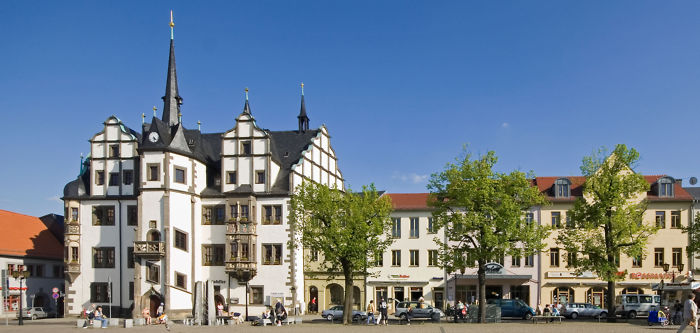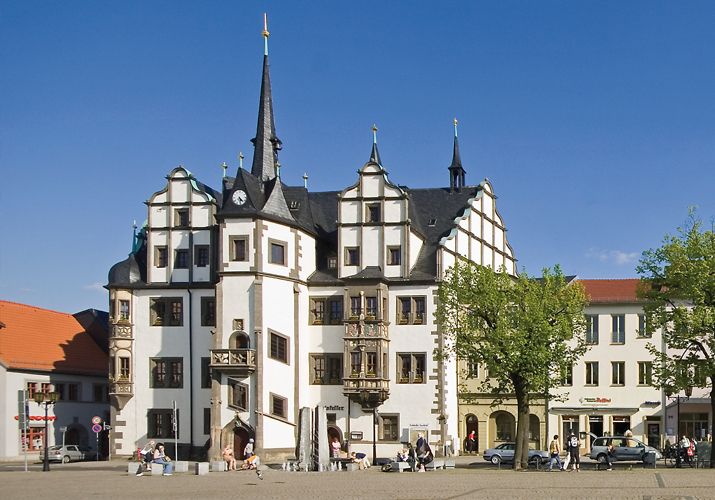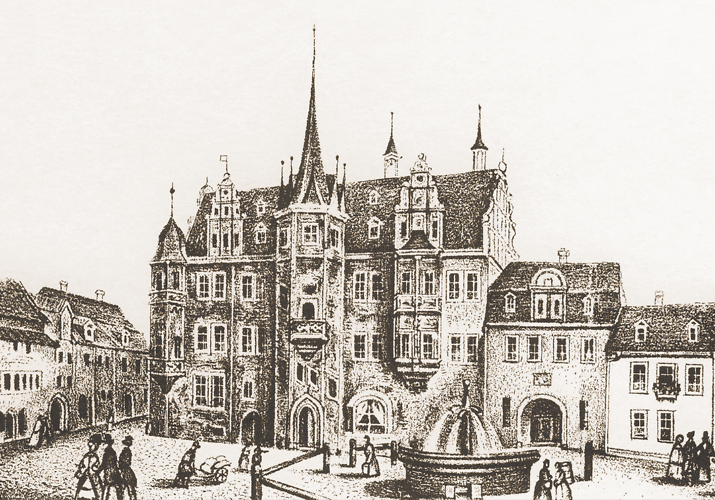The Town Hall (Markt1)
This beautiful building was constructed in 1530 according to the latest fashion of the time. The architectural style is very similar to that of the French palace style of construction and reflects the pride and assurance of the Saalfeld citizens. It is here that the local late-gothic building tradition was combined with modern Renaissance elements, to form a harmonious entity. The master builder of this; the earliest house in the square, is unknown.
Above the Town Hall’s entrance portal, which takes the form of a late-gothic pointed arch, you will notice a proclamation balcony, which is crowned by the town’s coat of arms. In the coat of arms you will recognise two fishes. These are barbel. This excellent culinary fish was once very common in the River Saale. Saale barbel, which can either be grilled or made into a soup with onions, garlic, herbs and root spices, are still a special gourmet delight today. During the Middle Ages, because of the many days of fasting, fish was considered a basic food. For this reason fishing was regulated. Therefore, dried, smoked and salted sea fish became popular. Salted herrings were symbolic of these periods of fasting, and these were traded throughout Europe. To the left of the Town Hall entrance, you can see the Saalfeld “elle” or cubit. This iron strip is 56.6 centimetres long. The cubit was the standard unit of measurement for the textile trading, which took place on the second floor of the Town Hall at the beginning of the 19th Century.
While the oriel window on the left hand side of the building is late-gothic in style, the two-storey oriel on the right hand side displays distinct Renaissance features. One can admire here the splendid coloured heraldic stones. These are dedicated to Elector Johann Friedrich the Magnanimous of Saxony and his consort Sibylle of Cleves, as a symbol of the Saxon sovereignty over the town.
When the Town Hall was built, the town still belonged to Saxony. At that time the town was greatly loved by the Saxon dukes and they often conducted their state parliaments here.
On the ground floor of the house, special culinary delights await lovers of good food: the “Ratskeller“restaurant will spoil you in its historical surroundings.
Standing to the right of the Town Hall is the former Syndicate Building. This was the official residence of the town lawyer. He represented the municipal administration in legal matters. Originally the building had a large arched passage way through, which the Saalfeld bakers made use of to sell their wares. It was also an opportunity to have a good chat!
There is a well-known rhyme in local dialect, which roughly translates as follows:
Now let’s go over to the Town Hall,
And stand before the door.
But first the rascal must fetch for us
A roll from the baker’s stall.
In the Town Hall courtyard you will find a circular building which locals have nicknamed “The Hat Box”. This was the former Saalfeld Jail, and was still in use until the middle of the 20th Century. The last execution in Saalfeld took place in 1917. Today this circular building houses the town Archives, which contain documents substantiating all these events.
Please turn your attention to the Market square Fountain in front of the Town Hall.
The Market square Fountain was created by the Saalfeld artist Kristian Körting. It is a synthesis between the lens-shaped water element and the paved surface of the market place. About a third of its cost was raised by residents and businesses in the town. Their names are documented in bronze on the paving stones at the edge of the fountain itself.
A local saying about the fountain goes:
“Water from the well is natural but not so decent to drink.
If you prefer pure water, then take it from the tap.”
From the Town Hall, proceed to the right hand side of the market place.


